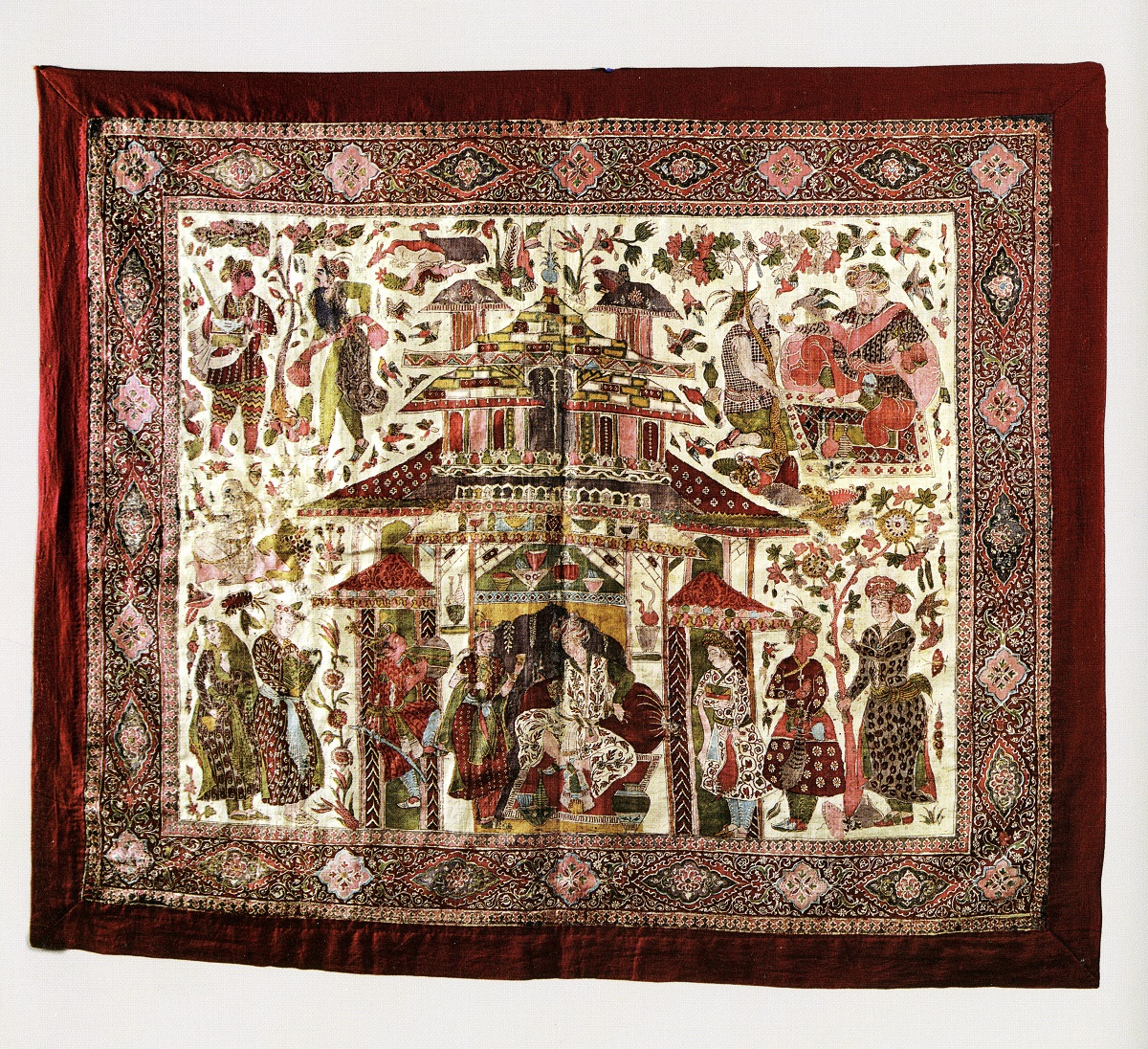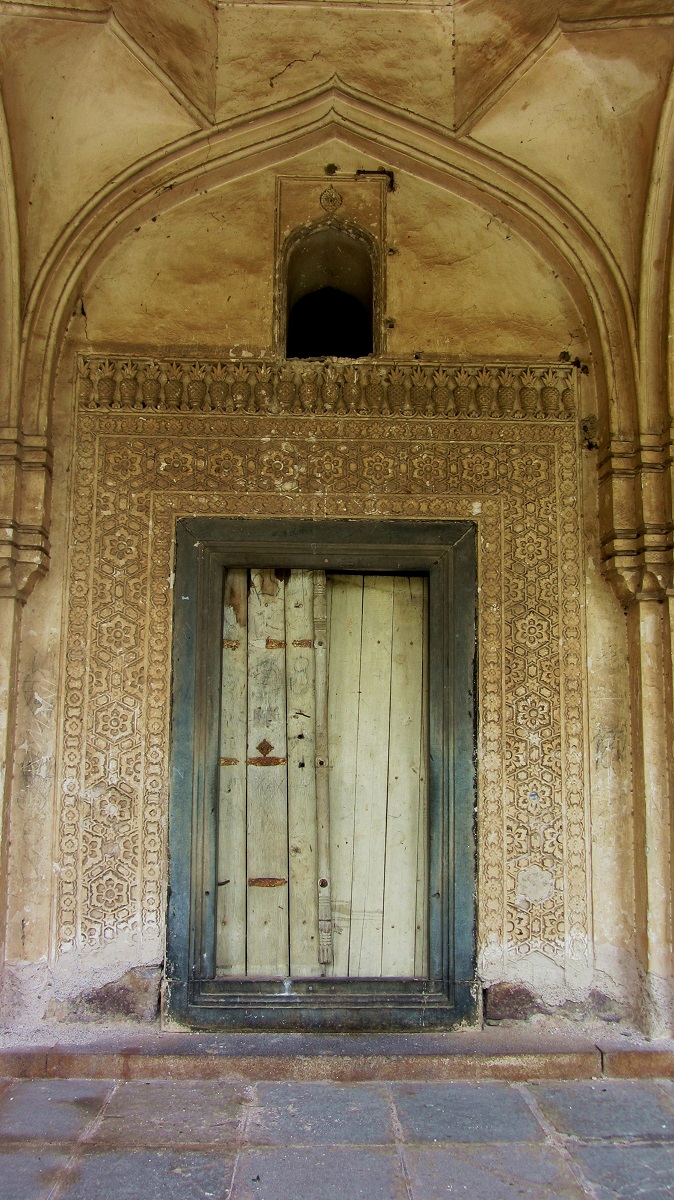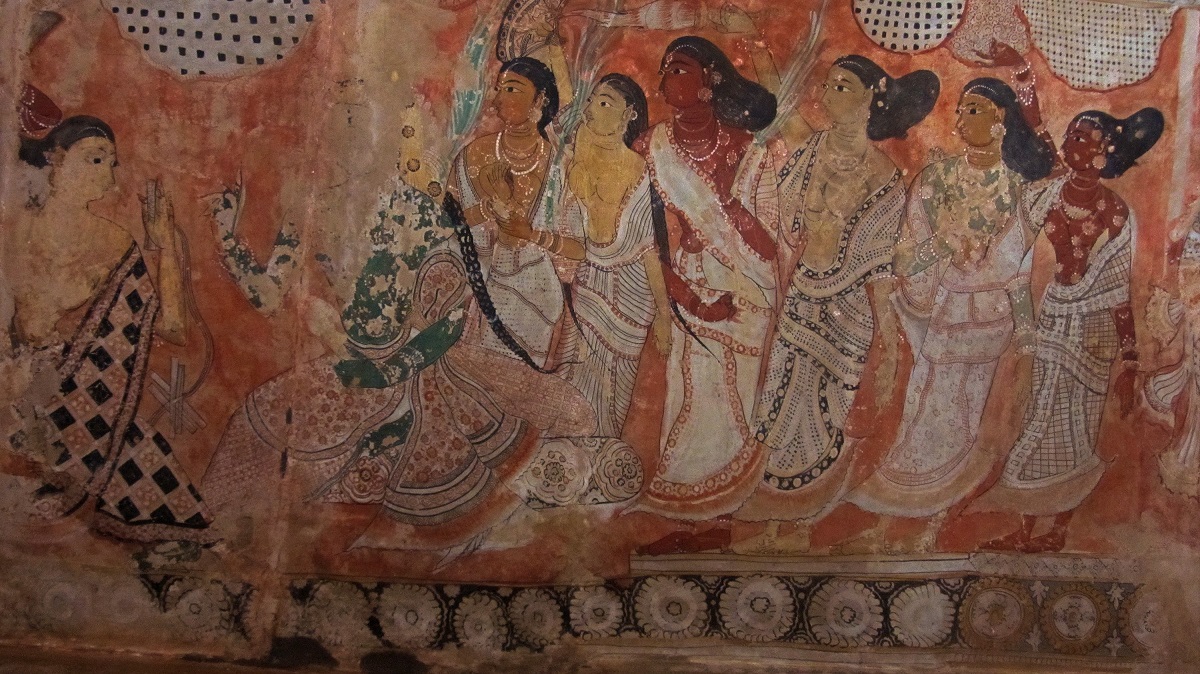
Fig. 1. Coverlet, Golconda region (possibly Petaboli), 17th Century. Cotton, drawn and painted with resist and mordant, 89 x 74 cm (with lining). The National Museum, New Delhi, 48.7/103. After Anamika Pathak, “Coverlet,” in Nauras: The Many Arts of the Deccan, ed. Preeti Bahadur Ramaswami and Kavita Singh (New Delhi: National Museum, 2015), 32.
The Golconda Coverlet, produced in the dyeing and painting workshops of the Coromandel Coast of southeastern India during the seventeenth century, presents a glimpse into the unique cosmopolitan world of the early modern Deccan (Fig. 1).[1] The term Deccan indicates the plateau in South India surrounded by the Malabar Coast to the west, the Vindhya Mountain range to the north, and the Coromandel Coast to the east. “Golconda” refers to the circular fort city in the heart of the Deccan Plateau that also served as the capital of the Qutb Shahi Sultanate from 1518 to 1590. The Golconda coverlet embodies the essence of many gatherings, found most prominently in its portrayal of people from varied ethnicities and social backgrounds. The fluidity of visual transmission between textile and architectural practices, also found in the coverlet, indicates a close relationship between the various artisanal communities of the Deccan.
With the advent of maritime trading activities in the Deccan and the Coromandel Coast beginning in the sixteenth century, the dyed, painted, and printed cotton textiles produced in the coastal workshops reached the intra-Asian and inter-Asian consumer worlds.[2] After India’s independence, a renewed interest in Indian crafts, establishment of the Calico Museum of Textiles in Ahmedabad, and international exhibitions on Indian crafts have drawn scholars to examine various aspects of these Coromandel textiles, such as their formal and iconographic features, position in the trade network, and impact on global design history.[3] Building on this scholarship, my research highlights the intermediality of visual elements reflecting complex mercantile, cultural, and artisanal networks in the Golconda coverlet, offering insights into the nature of cosmopolitanism in the early modern Deccan and Southern India.[4]
Coverlets, also called rumal in Hindi and Dakhni, were used as coverings for gifts and in furnishings. These coverlets are square or rectangular in shape and were employed by elites as covering for furniture and food, among other objects. The ornate coverlets usually follow a symmetrical organization of visual motifs or contain a central motif. Given its strong emphasis on figurative narrations, this coverlet could possibly be used for other purposes, such as hanging for display. The design of this particular coverlet centers on a multi-storied courtly architectural complex housing a royal male accompanied by one female and two male attendants. The royal figure wears an elaborate turban,[5] a jama (robe) with floral motifs, and a sash tied around his waist. Towards the upper left of the coverlet, a messenger enters the picture plane with a message. A courtier approaches him while tightening his waist hand as if he is suddenly awakened by the call of the messenger.
The other three corners represent groups of merry drinkers. Towards the right, an East Asian man appears, dressed in a conical hat and checkered waistcoat. He smilingly gazes at the bearded and fair-skinned royal figure, who is portrayed as cheerfully drunk by offering his wine cup to a bird. Away from the gatherings, a seated ascetic is seen between the two groups on the left. He sits on a deer skin on a rocky ground and holds a pineapple in his left hand. His yogic status is confirmed by the yogapatta (a band used during yoga) tied around his legs. He turns away from the narrative occurrences of the picture plane to instead engage with the fruit.
Ever since the pineapple (ananás in Portuguese, which in Urdu and Hindi became ananas) arrived in Golconda from South America with Portuguese traders in the sixteenth century, it started appearing in the courtly and popular practices of this region. The association between this transnational fruit and a solitary ascetic brings different worldviews into conversation.[6] This perhaps represents a core characteristic of early modern cosmopolitanism: respectful co-existence of seemingly differing ideas and different states of engagement with the material world.

Fig. 2. North Doorway to Abdullah Qutb Shah’stomb, Qutb Shahi Tomb complex, Hyderabad, 1670s. Photo: Rajarshi Sengupta.
The central architectural complex represents an intermedial “gathering” through the visual synthesis of permanent structures and makeshift tents. Brick-like rectangular motifs and red dotted textile-like surfaces coexist in the structure, as seen in the central and corner towers above the roof and the brilliant red tent structure behind. A pineapple-like towering member is seen on the top of the pyramidal roof of the architectural complex. The pineapple motif is similarly found on the Qutb Shahi (Fig. 2) and Paigah tomb architecture in Hyderabad. For its status as a foreign fruit with an extraordinary visual presence and a belief associating good health with pineapple, it began appearing across media in the Deccan from the seventeenth century. The formal similitude between pineapples and date trees, highly praised in the Islamic texts and widely represented in Islamic visual culture, might also have accelerated the pineapple’s entry into Deccani architecture.
The coverlet’s visual program has been created through an amalgamation of techniques. The thick border is made through stenciling and mordant dyeing, in which fixative agents such as alum are applied prior to the application of dyes. The figurative motifs are hand drawn, whereas resist-dyeing is used in the details of textiles. Scholars have drawn visual connections between the sixteenth- and seventeenth-century Vijayanagara temple murals (Fig. 3) in South India and textile painting.[7] These mural paintings thrive on their linearity, intricate details, and elaborate depiction of textiles. The fluid linearity, graceful forms, and rhythmic movement of forms and ideas in the coverlet remind us of the cross-media references between the textiles and the murals. Analysis of the visual and artistic processes leads us to the rather understudied realm of artisanal histories. The painters, dyers, printers, and block-makers of the Coromandel region developed a highly complex knowledge system by translating intercultural and transmedial knowledge into visual depictions. The collective engagement of the artisans and their workshop spaces accommodated and nurtured the gathering of diverse visual elements, architectural styles, and complex techniques to produce these historic textiles.
Rajarshi Sengupta is a researcher, artist, and PhD candidate in Art History at the University of British Columbia, Vancouver
[1] This coverlet (Acc. No. 48.7/103) was displayed in the exhibition Nauras: The Many Arts of the Deccan at the National Museum, New Delhi, in 2015. See Anamika Pathak, “Coverlet,” in Nauras: The Many Arts of the Deccan, ed. Preeti Bahadur Ramaswami and Kavita Singh (New Delhi: National Museum, 2015), 32-3.
[2] The history of trading activities in the Coromandel region goes back to Pallava era (beginning in the fourth century CE) and even beyond. However, for our discussion, the later trading activities of the sixteenth-century Coromandel region are relevant. Economic and social historians such as Sanjay Subrahmanyam, S. Arasaratnam, Giorgio Riello and others have written extensively about the growing prominence of the Coromandel trade routes in this period, linking it to the closure of the historic Silk Route.
[3] The 1950s was an important period for scholarship on Coromandel textiles. Art historians and curators John Irwin, Margaret Hall and Katharine Brett initiated the formal and iconographic studies of the textiles, which were further explored by Lotika Varadarajan, Mattiebelle Gittinger, Rosemary Crill, Stephen Cohen, John Guy, and Amelia Peck, among others.
[4] Coromandel textiles have triggered the interest of scholars from diverse disciplines, namely art history, anthropology, sociology, economic and political history. Some of the major collections of these textiles are The Calico Museum of Textiles, Ahmedabad (India); Victoria and Albert Museum, London (UK); Fukuoka Art Museum, Fukuoka (Japan); and the Metropolitan Museum of Art, New York (U.S.).
[5] Turbans of long cloth forming a dome shape are associated with the Safavid style of dressing. See Marika Sardar, “The Courtly Tradition of Kalamkaris,” in Sultans of Deccan India 1500-1700: Opulence and Fantasy, ed. Navina Najat Haidar and Marika Sardar (New York: The Metropolitan Museum of Art, 2015), 270.
[6] John Guy discusses Coromandel textiles with pineapple motifs and the Western interest in this South American fruit during the early modern period. See John Guy, “Long Cloth,” in Interwoven Globe: The Worldwide Textile Trade, 1500-1800, ed. Amelia Peck (New York: The Metropolitan Museum of Art, 2013), 199-200.
Cite this note as: Rajarshi Sengupta, “Many Gatherings: The Cosmopolitan World of a Golconda Coverlet,” Journal18 (October 2017), https://www.journal18.org/2006
Licence: CC BY-NC
Journal18 is published under a Creative Commons CC BY-NC International 4.0 license. Use of any content published in Journal18 must be for non-commercial purposes and appropriate credit must be given to the author of the content. Details for appropriate citation appear above.

